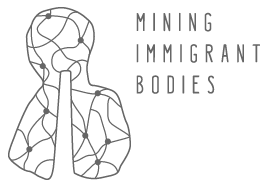Project Leader
Stacey Zembrzycki is a Sudburian who currently lives in Montreal, Quebec, where she is an Affiliate Assistant Professor in Concordia University’s Department of History. The granddaughter of two miners who came from Warsaw, Poland, and Mossey River, Manitoba, to work in Sudbury’s nickel mines in the postwar period, she spent the bulk of her childhood in their homes, located in both the Donovan and the downtown core, listening to their stories, as well as the ones told by her grandmothers. These stories, many of which focused on the connections between place and health, have inspired her to think deeply about how Sudbury’s industrial past lingers in the present. This is Stacey’s second major project in the region. The first resulted in the publication of her recent book on Sudbury’s Ukrainian community: According to Baba: A Collaborative Oral History of Sudbury’s Ukrainian Community (UBC Press, 2014), and its accompanying website: www.sudburyukrainians.ca.
Team Members
Kaleigh Bradley is a Sudburian who currently lives in Toronto where she is a PhD candidate at York University, specializing in Indigenous and Environmental History. Kaleigh’s family has deep roots in the region’s nickel industry: her father currently works at Glencore and her late grandfather was a lifelong employee at INCO. Both of her parents’ families, of French-Canadian, Indigenous, and Irish descent, came to Sudbury in the 1940s to work in this heavy industry. After hearing about the potential demolition of the INCO Superstack in Fall 2014, Kaleigh started to question how different generations of Sudburians remember and make connections to the industrial ruins and environmental legacies inherent in the region’s landscape. To this end, she is deeply interested in how our histories, memories, and identities are influenced by the places we inhabit. How are our life stories shaped by the landscapes we call home? Or, how do we shape our landscapes to reflect our histories? This is Kaleigh’s first project in Sudbury.
Mike Commito is an environmental historian living in Sudbury. He has called this city home since the age of fifteen and is intimately familiar with how the area’s mining industry has shaped the landscape and the lives of Sudburians. After purchasing his first house in the region, Mike learned that the property had smoke easements from both INCO (Vale) and Falconbridge (Glencore), legal remnants from the time when both nickel producers could pollute with near immunity. More personally, Mike’s paternal grandfather worked for Falconbridge and later succumbed to occupational lung cancer. He and Kaleigh Bradley recently examined how Sudburians view and attach meaning to the INCO Superstack.
Stephanie Conway completed a Masters degree in Environmental Studies at York University where she developed a keen interest in theories of culture, place, bodies and nature. As a Humanities teacher at Champlain College in Montreal, Quebec, she used a holistic approach to teach her students how to make connections between environmental and social issues in their everyday lives. She is excited to be a part of the Mining Immigrant Bodies project since it not only challenges discourses that construct labour and the environment in binary ways, but also documents the struggle for human recognition, making clear that miners’ bodies and lives matter. Stephanie’s own life has been touched by cancer and she believes that environmental links to this disease have to be better researched and exposed. Stephanie, who now lives in Toronto, can often be found at the Archives of Ontario, where she is playing an important role in bringing the documentary nature of this project to life.
Image credits: Northway-Gestalt Corporation [photograph], ca. 1954, Ontario-Sudbury-International Nickel Company, Copper Cliff, C30-1: Container E55-258-383, Archives of Ontario.
